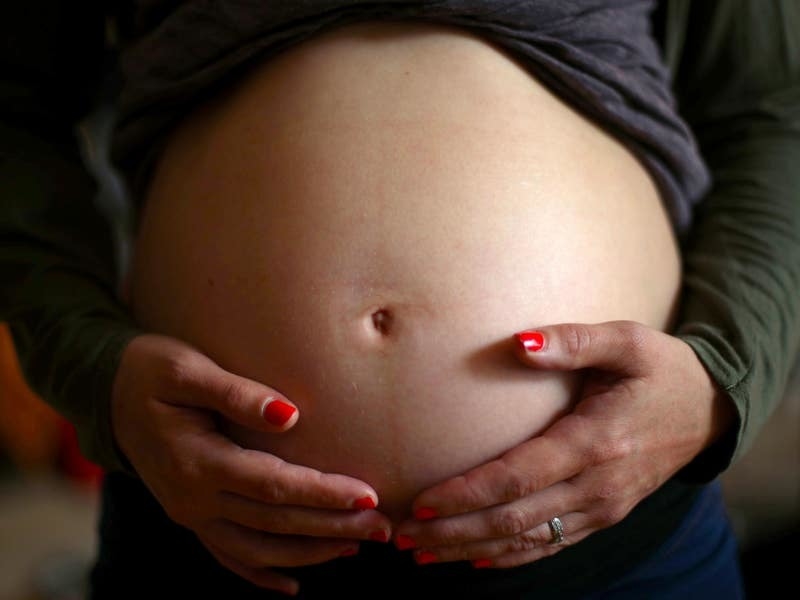Adding a third routine scan at the end of pregnancy could be a “game-changer to pregnancy and birth care”, a new study suggests.
Researchers say the additional appointment could slash the number of unexpected breech births by 70% and the risks of the baby being born with severe health complications.
They hope their findings will lead to a change in National Institute for Health and Care Excellence (Nice) guidelines so all pregnant women are offered a scan in their third trimester.
Pregnant women currently have routine scans at 12 and 20 weeks only, and they are only referred for further observation if they are flagged at risk of a complicated pregnancy at one of the earlier scans.
This means the baby is positioned feet or bottom first which puts them at increased risk of being admitted to the neonatal unit, brain injury due to a lack of oxygen, or even death.
Asma Khalil, professor of obstetrics and maternal foetal medicine at St George’s, University of London, who led the study, said: “It’s vital we know how the baby is lying towards the end of pregnancy as we want to avoid a breech birth if at all possible.
“The two routine scans are far too early to tell us how the baby will be positioned at the time of labour and that’s why a third scan at 36-37 weeks could be a game-changer to pregnancy and birth care.”
Doctors compared the rate of unexpected breech births and the health of the newborn baby after different third trimester scan policies were introduced at St George’s University Hospital NHS Foundation Trust (SGUH) and Norfolk and Norwich University Hospital NHS Foundation Trust (NNUH).
A total of 24,128 pregnant women were recruited at SGUH, of whom 16,777 received the usual antenatal ultrasound scans.
Some 7,351 had an extra ultrasound scan by a sonographer at 36 weeks.
At NNUH, 9,694 women were recruited of whom 5,119 women received standard ultrasound scans and 4,575 were given a “point-of-care” ultrasound scan at 36 weeks using a hand-held, portable device that brings the scan up on a phone or tablet.
According to the study, both types of third trimester ultrasound scan dramatically reduced the rate of unexpected breech births – 71% lower with the standard type of ultrasound at SGUH and 69% lower with the hand-held portable device at NNUH.
The researchers also found that the babies of women who had the third ultrasound were 16% less likely to be admitted to the neonatal unit for closer monitoring,
They were also 40-77% less likely to have a low Apgar score at five minutes after being born.
The Apgar score assesses appearance and skin colour, heart rate, reflexes, muscle function, ability to breathe, and is an assessment of the baby’s wellbeing soon after birth.
Prof Khalil added: “For the first time we’ve shown that just one extra scan could save mothers-to-be from trauma, an emergency C-section, and their babies from having severe health complications which could otherwise have been prevented.
“Our research comes at a time when there’s a spotlight on the safety of maternity services and provides the NHS with a clear solution to help enable maternity units better prepare for safer, healthier births.”
She hopes more midwives can be trained to use the hand-held ultrasound device so pregnant women can have easy access to a third trimester scan either at home or at hospital.
Fran Harlow, consultant obstetrician for the NNUH, said: “This paper demonstrates the huge impact and improvement in patient care by carrying out an additional scan in the third trimester.
“At NNUH all our midwives have been trained to routinely perform hand-held, bedside ultrasound scans using a machine smaller than a tablet, to look at the position of the baby.
“We are delighted that this study has shown that the benefits to the mother and baby are equivalent to a formal scan performed by an ultra-sonographer. This keeps care in the community and woman centred.
“We hope that the data from NNUH and St George’s provides the stimulus for a national policy of third trimester scanning.
“In addition, this study has demonstrated that use of a hand-held ultrasound device by a midwife is an innovative, progressive, and now proven, way of achieving this.”
The findings are published in the PLOS Medicine journal.
A Nice spokesman said: “The safety of mothers and their babies is at the forefront of our committee’s mind when they produce evidence-based recommendations.
“Our antenatal care guideline covers whether ultrasound scans should routinely be offered after 28 weeks for uncomplicated single baby pregnancies and provides several recommendations on identifying and managing breech presentation.
“The guideline recommends midwives examine women’s abdomens by touch at all appointments after 36 weeks to identify possible breech presentation for women carrying one baby.
“If breech presentation is suspected, an ultrasound scan is used to confirm if this is the case.
“We welcome technological development and the generation of new evidence in this important area, and we will review this study to see if our recommendations need to be updated.”






